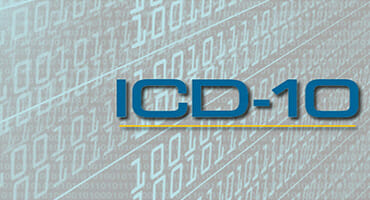Synopsis
Effective October 1, 2015 some payers will begin to require that ICD-10 (diagnostic) coding begin to be included on claim forms. Some payers will likely not require this immediately. However, the AAO wants our member offices to be prepared in case they are asked for this coding.
If your office has access to version 2012 of the American Dental Association claim form you will have accomplished most of what you need to do in order to be prepared. If your office files electronically, make sure that your practice management software includes the 2012 version of the claim form and that you have the ability to populate boxes 34 and 34a of the form. Click on the link in Question 6 below to view the ADA clalim form, version 2012.
If you file claims manually, be sure to have a supply of the 2012 forms on hand. These forms can be ordered via the ADA Store.
Order the 2012 ADA Form
The AAO has prepared a specialized guide, the ICD-10 Coding Crosswalk, to provide you with the ICD-10 codes needed for use in box 34a of the claim form. Click on the link in Question 2 below to obtain your copy of the crosswalk.
We recommend that you do not begin to include the ICD-10 coding until individual payers begin to request it. Many of the payers do not have their claims adjudication systems programmed to accept this yet.
Please contact Andrew Wiltsch at [email protected] with any questions about ICD-10 coding. Also, consider registering yourself and/or your staff for the AAO’s free ICD-10 webinar (see information in Question 3 below).
QUESTION 1: What is ICD-10 Coding and how will it be used?
ANSWER: Effective October 1, 2015, all dental providers will be expected to be prepared to begin using ICD-10 coding on claims submitted for payment. As of that date, many payers will begin to require a diagnostic component on the claim form before claims can be adjudicated. The ICD-10 code set provides payers with a snapshot of why treatment is being performed. In addition to helping identify medical necessity; these codes are also a means for payers to compile data on the following:
- Statistical Information
- Tracking Morbidity and Mortality
- Epidemiology
QUESTION 2 : Where can ICD-10 codes be found or obtained?
ANSWER: The AAO Council on Orthodontic Health Care (COHC) has put together a coding crosswalk (specialized coding guide) intended to provide ICD-10 coding for all the diagnoses you can expect to encounter in orthodontic practice.
Download Your Copy of the AAO COHC ICD-10 Coding Crosswalk
The coding crosswalk includes an introduction and how-to guidelines prepared by Dr. Kirt Simmons, an AAO member who has worked extensively with the American Dental Association Standards Committee on Dental Informatics (SCDI). AAO representatives affiliated with various sub-committees of the ADA SCDI have worked to ensure orthodontic inclusion in development of codes to be used in Electronic Health Records (EHRs).
Learn More about How Orthodontics Was Represented in the Coding Change Process
QUESTION 3 : Is the AAO providing any other educational resources on this topic?
ANSWER: The AAO Council on Orthodontic Health Care will sponsor a free ICD-10 webinar for AAO members and their employees that will provide in-depth information. Notify your staff and mark your calendar for one of the following dates:
- Tuesday, October 13, 2015 at 12 PM Central time; or
- Tuesday, October 20, 2015 at 8 PM Central time
The webinar will be 75 minutes long. Registration, which is required, is open.
Register for the Webinar
After the live webcasts, the recorded webinar will also be available at no cost in the Business of Orthodontics section of AAO Online Lectures.
QUESTION 4: How will I know when to start using ICD-10 coding?
ANSWER: Payers are working to program their claims systems to accept the additional data. As payment systems are converted, payers will communicate with providers to let them know when to start including this information on claim forms.
QUESTION 5: Will dental codes be replaced?
ANSWER: No. You will continue to use the same procedure codes (CDT, D8080, etc.) that you use now. You will report an appropriate ICD diagnostic code for dental conditions along with the applicable CDT code for the service performed.
QUESTION 6: Where will the ICD-10 code be entered?
ANSWER: Your practice management software program will need to support Version 2012 of the ADA claim form. You will be able to insert diagnostic coding in Box 34 of this form. When the form asks for “Diagnosis Code List Qualifier” you will place “AB” in the boxes if you are using ICD-10 coding. If, for some reason you are still using ICD-9 coding, the prior code set, you will insert a “B” in the box. Actual diagnoses will be placed in section 34a with the primary diagnosis placed first in “A” followed by other accompanying diagnoses in order of severity.
View Version 2012 of the ADA Claim Form
QUESTION 7 : What if we need additional information?
ANSWER: You may contact Andrew Wiltsch at [email protected] with any questions.



